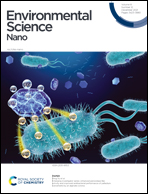Uptake and depuration of carbon- and boron nitride-based nanomaterials in the protozoa Tetrahymena thermophila†
Abstract
Quantifying bioaccumulation is important in environmental contaminant risk assessment. Engineered nanomaterials (ENMs) are contaminants of emerging concern (CECs) that can enter organisms and bioaccumulate, but more understanding is needed regarding how to measure and model ENM biological uptake and elimination. Conventional chemical analysis and microscopic approaches inadequately differentiate ENMs from carbon-rich organisms, and thus do not allow for directly understanding where, and to what degree, ENMs bioaccumulate in organisms. Here we present a microscopy and image analysis-based approach for quantifying uptake and depuration kinetics of carbonaceous ENMs; we also apply the methods to boron nitride-based ENMs. The phagotrophic protist Tetrahymena thermophila was exposed to subinhibitory levels (10 mg L−1) of multiwall carbon nanotubes (CNTs), graphene nanoplatelets (GNPs), carbon black (CB), hexagonal boron nitride flakes (hBN) and boron nitride nanotubes (BNNTs). Uptake and depuration were assessed using quantitative microscopy of ENMs in food vacuoles, with the results for CNTs benchmarked to prior studies using 14C-labeled ENMs. Kinetically derived bioaccumulation factors (BCFs) indicated that only hBN was bioaccumulative, i.e. with a BCF > 1000 L kg−1. The uptake rates were similar for all three carbonaceous ENMs, but significantly higher and lower, respectively, for hBN and BNNTs compared to carbonaceous ENMs. Uptake appeared to correlate with the tapped densities of the ENMs, i.e., ratio of ENM mass to the volume occupied after tapping to constant volume, assumed to be representative of the ENM “packing” density in protozoan food vacuoles. Depuration was relatively slower for the tubular ENMs (CNTs and BNNTs) compared to planar (GNPs and hBN) and spherical (CB) ENMs, and the first order depuration rate coefficients measured over 2 hours correlated significantly (P = 0.03) with ENM aspect ratios (the ratio of length to width of a particle) which were highest for the tubular ENMs. This suggests that intracellular residence times are longer for high-aspect-ratio ENMs due to impaired phagosomal expulsion. Such findings, and the approaches herein, may be relevant when considering bioaccumulation of other C-rich CECs such as nano- or micro-plastic particles or fibers, for which crucial environmental risk assessment data are limited.



 Please wait while we load your content...
Please wait while we load your content...
